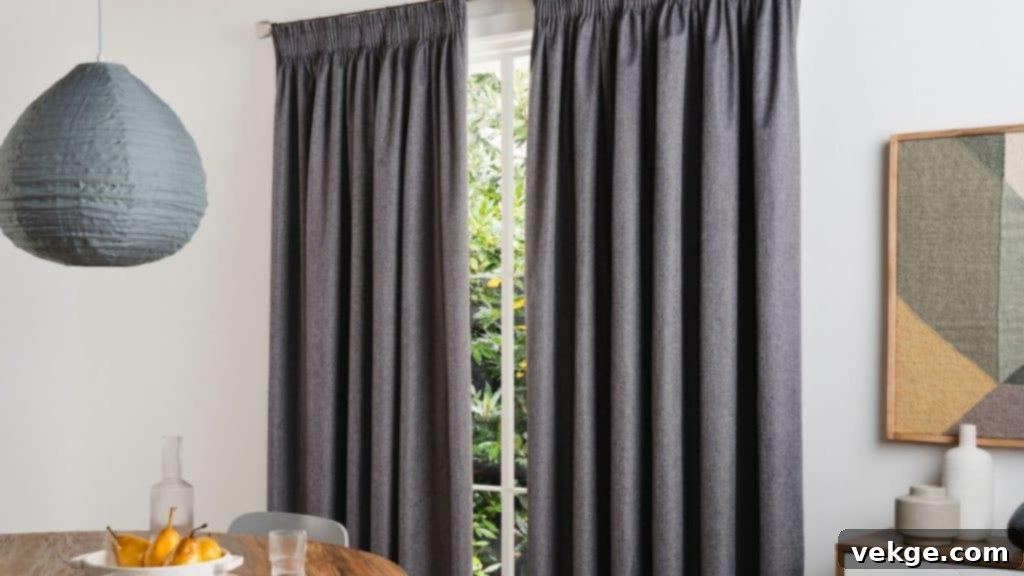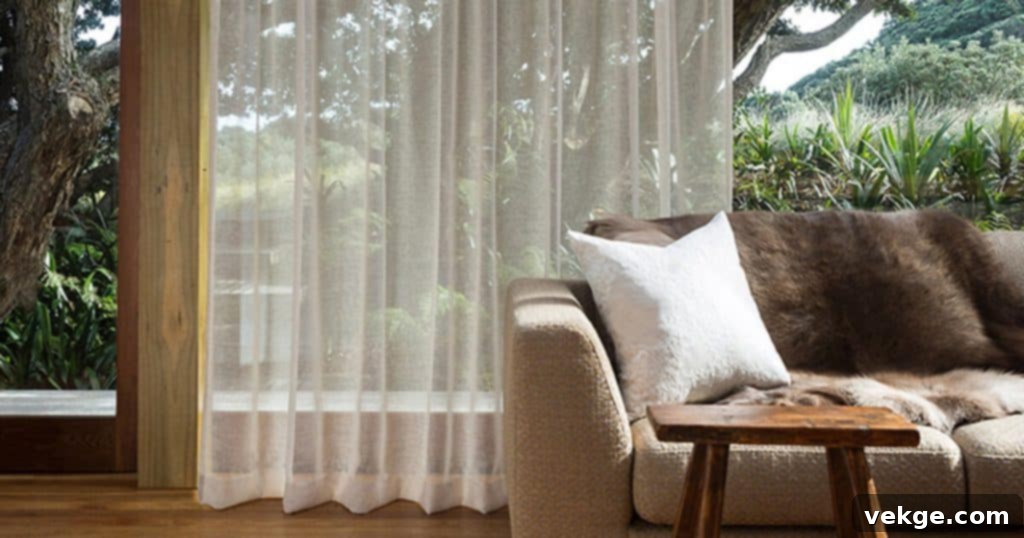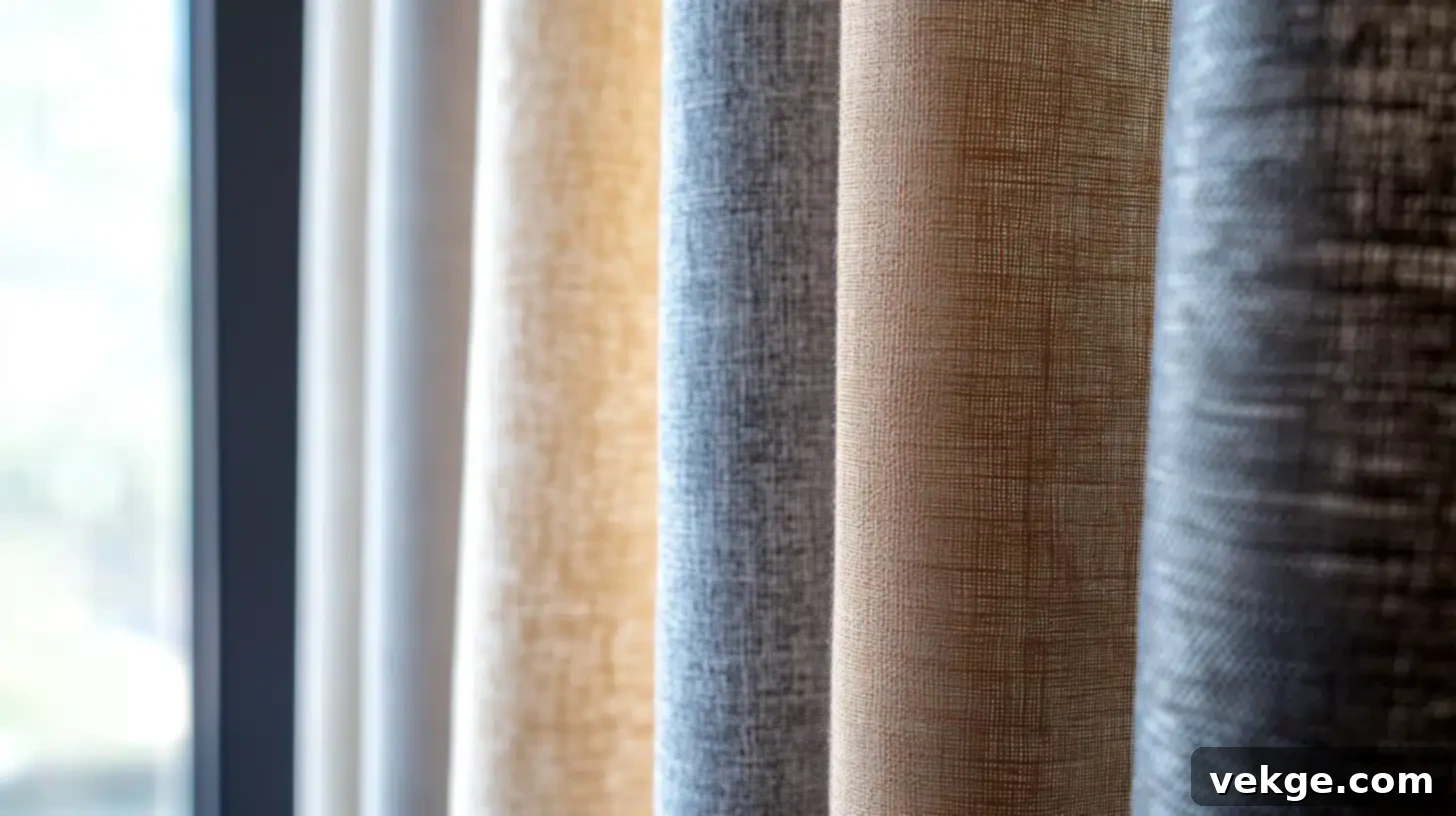The Ultimate Guide to Choosing Curtain Fabric: Types, Benefits, and Expert Tips for Your Home
Curtains are far more than just functional window coverings; they are a pivotal element in defining the aesthetic and atmosphere of any room. The type of fabric you select for your curtains plays an incredibly significant role, influencing everything from light filtration and privacy to insulation and sound acoustics. It’s a key decision that can dramatically transform your living space, making it feel either cozy and inviting, sleek and modern, or grand and luxurious.
The fabric of your curtains, much like other furnishings in your home or office, contributes immensely to the overall comfort and style you wish to achieve. Whether you’re aiming for a snug, comfortable haven or a sophisticated, contemporary design, understanding the characteristics of various curtain fabrics is essential. This comprehensive guide will explore the many kinds of curtain fabrics available, discuss their distinct advantages, and provide expert advice on how to choose the perfect material to meet your specific requirements and elevate your interior design.
Explore the Diverse World of Curtain Fabrics

Each fabric offers a unique blend of visual appeal and practical benefits. Let’s delve into the most popular curtain fabric types:
Cotton Curtains: Versatile and Breathable
Cotton remains a perennial favorite for curtain distinction due to its remarkable versatility and inherent durability. Available in an extensive array of colors, patterns, and weaves, cotton curtains can effortlessly complement almost any decor style, from rustic farmhouse to chic minimalist. This natural fiber is celebrated for its breathability, allowing for good air circulation, and its ease of care, as most cotton curtains are machine washable. They are an excellent choice for high-traffic areas like living rooms and especially well-suited for kitchens, where their washability and fresh appearance are highly valued. Cotton can offer anything from a light, airy feel to a more structured look, depending on its weave and weight, making it a truly adaptable option for various aesthetic needs.
Linen Curtains: Effortless Elegance and Airiness
Linen curtains bring a natural texture and an effortlessly elegant drape that enhances the beauty of any room. This lightweight fabric is characterized by its slightly loose weave, which allows a generous amount of natural light to filter through, creating a soft, ethereal glow and a wonderfully airy atmosphere. Linen is perfect for achieving a relaxed, sophisticated, and organic look. Its subtle imperfections and tendency to wrinkle are often considered part of its charm, adding character and an inviting lived-in feel. While linen curtains may require a bit more attention to maintain their crispness if desired, their natural beauty and light-diffusing qualities make them a superb choice for living rooms, dining areas, and bedrooms where a gentle illumination is preferred.
Polyester Curtains: Durable, Practical, and Budget-Friendly
Polyester stands out as a highly popular synthetic fabric known for its exceptional durability and resistance to common issues like fading, shrinking, and wrinkling. Often blended with other fibers to enhance softness or mimic the appearance of more expensive materials, polyester offers a practical and cost-effective solution for window treatments. These curtains are remarkably low maintenance, making them an ideal choice for busy households and high-traffic areas such as children’s rooms, family rooms, or rental properties. Polyester curtains are also available in a vast selection of textures, patterns, and colors, providing ample design flexibility without compromising on performance or budget. They are particularly resilient to moisture and sunlight, ensuring they maintain their look for years to come.
Velvet Curtains: Luxurious Depth and Superior Insulation
For those seeking a touch of opulence and grandeur, velvet curtains are an unparalleled choice. The rich texture and deep saturation of color in velvet instantly elevate any room, imbuing it with a sense of luxury and warmth. Beyond their visual appeal, velvet curtains offer excellent functional benefits; their dense pile acts as a fantastic insulator, helping to keep rooms warmer in winter and cooler in summer, potentially reducing energy bills. They also possess superior sound-damping properties, making them ideal for creating a quiet, serene environment in bedrooms, home theaters, or formal living areas. While velvet requires more careful cleaning and maintenance to preserve its plush appearance and avoid marking, its ability to transform a space into a grand, intimate sanctuary is truly unmatched.
Silk Curtains: Unrivaled Elegance and Refinement
Silk curtains are the epitome of elegance and refinement, instantly adding a lovely sheen and graceful drape that complements luxurious décor. Their lightweight nature allows them to flow beautifully, creating a sophisticated silhouette at the window. However, silk is a delicate fabric that can be prone to fading when exposed to bright, direct sunlight. To preserve its lustrous beauty and rich color, silk curtains often require dry cleaning, which typically entails higher maintenance efforts and costs. Despite these considerations, the unparalleled beauty, soft touch, and opulent feel of silk make it a favored choice for formal dining rooms, master bedrooms, and other spaces where an air of unparalleled luxury is desired. For a more durable and budget-friendly alternative with a similar look, faux silk is also an excellent option.
Blackout Fabric Curtains: Ultimate Privacy and Light Control
When privacy, superior light control, and enhanced insulation are your primary concerns, blackout fabrics are an absolute necessity. These specialized curtains are typically constructed from dense polyester weaves or multiple layers designed to completely block out sunlight and external light sources, making them perfect for bedrooms, nurseries, or home theaters where darkness is paramount. Beyond light blocking, blackout curtains offer significant thermal insulation, contributing to energy efficiency by keeping rooms cooler in the summer and warmer in the winter. They also provide excellent sound insulation, reducing outside noise for a more peaceful interior. Blackout fabrics are a practical and highly effective solution for creating an optimal sleeping environment or enhancing the functionality of media rooms.
Key Considerations When Choosing Your Perfect Curtain Fabric

Selecting the right curtain fabric involves more than just aesthetics. Consider these crucial factors to ensure your choice meets all your needs:
1. Purpose: Defining Your Curtain’s Role
Before diving into fabric types, consider the primary function of your curtain fabric. Are you looking for ultimate privacy, precise light control, thermal insulation, noise reduction, or are your curtains primarily for decorative purposes? Understanding the end-use will significantly guide your fabric selection. For instance, if your goal is to completely block out light for a restful sleep, blackout fabrics are indispensable. If you aim to diffuse natural light while still maintaining some visibility and a bright atmosphere, sheer or linen fabrics might be more suitable. Curtains can also play a vital role in insulation, helping to regulate room temperature and reduce energy consumption, especially in rooms with older or less efficient windows.
2. Room Type: Tailoring Fabric to Environment
Different rooms within your home have unique requirements and environmental conditions. For areas prone to moisture, such as bathrooms and kitchens, selecting moisture-repellent and easily washable fabrics like polyester or specific treated cottons is wise, as humidity can shorten the lifespan of delicate materials. In children’s rooms, durability, ease of cleaning, and safety are paramount; lightweight, durable, and brightly patterned fabrics that can withstand active play and frequent washing are ideal. Conversely, in living rooms or bedrooms, heavier fabrics like velvet or silk can add warmth, intimacy, and a touch of luxury, while also providing better insulation and sound absorption. Matching the fabric to the room’s function ensures enhanced durability, performance, and overall suitability.
3. Style and Aesthetics: Harmonizing with Your Decor
The chosen fabric should seamlessly complement your existing interior décor, contributing to a cohesive and appealing look. Consider the room’s color palette, prevailing patterns, and existing textures. Lighter, sheer fabrics can make a room feel expansive, airy, and filled with natural light, perfect for contemporary or coastal themes. More substantial, darker fabrics, like a rich velvet or heavy linen, can introduce warmth, intimacy, and a sense of coziness, ideal for traditional or maximalist designs. The fabric’s drape, sheen, and texture significantly impact the overall visual appeal. When your curtains harmonize with your design theme, they help tie all elements together, creating a coherent space that accurately reflects your personal style and enhances the room’s ambiance.
4. Maintenance: Aligning with Your Lifestyle
The practicality of curtain maintenance is a crucial consideration that should align with your lifestyle. Certain fabrics, such as polyester and many cotton blends, are wonderfully low-maintenance, often being machine washable and requiring minimal ironing. These are excellent choices for busy households where convenience is key. In contrast, luxury fabrics like silk and velvet are high-maintenance, frequently requiring professional dry cleaning or specialized care to preserve their appearance and integrity. Others, like linen, might benefit from occasional steaming to remove wrinkles. Selecting a fabric that fits your willingness and capacity for upkeep will ensure your curtains remain beautiful and contribute positively to your home without adding unnecessary chores to your routine.
5. Budget: Balancing Quality and Cost
Curtain fabrics vary widely in price, from budget-friendly synthetics to premium natural fibers. It’s important to establish a clear budget early on, factoring in not only the cost of the raw material but also any additional expenses such as lining, custom tailoring, and installation hardware. While luxury and high-end fabrics often boast superior quality, longevity, and unique aesthetics, there are always numerous budget-friendly options that can effectively mimic the look and feel of their pricier counterparts. For instance, faux silk can offer the elegance of real silk without the high cost and demanding maintenance. Planning your budget thoughtfully ensures you can acquire beautiful curtains that meet your aesthetic needs without compromising your financial comfort or overextending your resources.
Essential Tips for Caring for Your Curtain Fabric
Proper care can significantly extend the life and beauty of your curtains. Here are some key tips:
- Regular Dusting: Dusting is paramount to maintaining any curtains in pristine condition. Weekly or bi-weekly cleaning of dust and debris can be easily accomplished using a handheld vacuum cleaner with a brush attachment or a lint roller. This prevents dust from embedding into the fibers, keeping your curtains looking fresh.
- Follow Washing Instructions: Always check the care label provided by the manufacturer before attempting to clean your curtains. Some fabrics, particularly robust synthetics and certain cottons, may be safely laundered in a washing machine, often on a gentle cycle with cold water. However, others, like delicate silks, velvets, or lined curtains, typically require professional dry cleaning to prevent damage, shrinking, or fading.
- Careful Ironing: If your curtains develop wrinkles, consult the fabric’s care label to determine if ironing is permissible. If so, select a suitable warmth setting consistent with the fabric type to prevent scorching or damage. Using a pressing cloth between the iron and the curtain fabric is often recommended, especially for delicate or textured materials, and steam can be highly effective for removing creases gently.
- Sun Protection: Direct and prolonged exposure to sunlight can cause curtain colors to fade over time. To protect your investment and preserve vibrancy, consider choosing curtains with UV-filtering linings or installing a separate sheer layer to diffuse harsh sunlight. Rotating curtains periodically if possible, or positioning them in locations that receive direct sun exposure only at certain times of the day, can also help minimize fading and prolong their beauty.
Conclusion: The Art of Choosing the Right Curtain Fabric
The fabric you choose for your curtains is undeniably an essential element in interior design, capable of imbuing your home with both significant aesthetic appeal and vital functional value. Each type of fabric possesses distinct characteristics and properties that collectively influence the ambiance, comfort, and overall vibe of a particular room. From the breathable versatility of cotton and the natural elegance of linen to the luxurious depth of velvet, the refined shimmer of silk, and the practical efficiency of blackout fabrics, understanding the unique attributes of each material is crucial for making an informed decision.
With so many factors to consider—including the specific purpose of the curtains, the unique demands of each room, your desired style and aesthetic, the practicality of maintenance, and your overall budget—you are now equipped to choose the best fabric for your curtains. Making a thoughtful selection ensures that your window treatments not only look stunning but also perform optimally, enhancing your interiors and making your space truly feel custom-built for your needs and preferences. Investing in the proper curtain fabric is an investment in the beauty, comfort, and functionality of your home.
